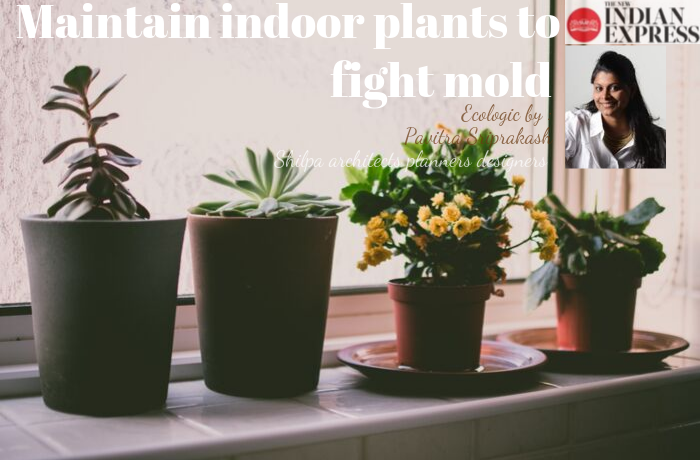12-Sept-2019: Pavitra Sriprakash, Director and Chief Designer at Shilpa Architects Planners Designers writes a weekly column on Sustainability for The New Indian Express titled “ECOLOGIC”. This week she writes about mold affecting air quality and how to keep your indoors fresh.
Full article below: (Also available at The New Indian Express Website)
Maintain indoor plants to fight mold
Mold poses a serious problem to good Indoor Air Quality, therefore it is imperative to get rid of it once detected. Some people are sensitive to molds and can suffer nasal stuffiness, throat irritation, coughing or wheezing, eye irritation, or in some cases, skin irritation.
The first step is identifying the source of the smell. Always start by checking for any water leak (try the plumbing, roof, walls, basement). Check air conditioning units or drain lines. Look for condensation, especially around windows or on exterior walls. Other overlooked spaces include those that have indoor plants, wastebaskets and trash cans (especially if not emptied frequently), empty beverage containers and glasses, food container recycling and materials that have been wet in the past (books, magazines, newspapers, carpet, or cardboard). Once identified and removed, it is a good idea to get a simple moisture absorbing block that will help keep the moisture levels in check.
Indoor Air Quality can be quite complicated — it has many aspects to it — ranging from levels of various toxins such VOC’s, carbon dioxide and other suspended particulate matter including bacteria and the common mold. It also deals with temperature and humidity control. While most architects and developers today understand ventilation, we need astronauts to teach us about oxygenation.
Oxygenation can simply be defined as the addition of oxygen to an entity — whether it is the human body, an astronauts’ suit or the space aboard a space craft. How is this relevant to us? Well, if we focused on adding oxygen to our indoor air, instead of constantly worrying about the flushing of carbon dioxide alone, the quality of our indoor air could be enhanced greatly.
A simple and elegant solution to add oxygen in our spaces is through the addition of plants that are featured in the NASA list. These are easily available in our country and grow very well indoors, with limited sun exposure. The top performer in this list is the variegated snake plant (commonly known as mother-in-law’s tongue), with others like bamboo palm, rubber plant and even aloe vera. With the ability to filter toxins from the air, the snake plant is also known for its high oxygen emitting capabilities — so you get cleansing and oxygenation by just adding some into your homes or offices. It is said that 6-8 waist-high plants can keep one person alive even if there was no air flow.
Think mold free and clean indoor air — it’s a few simple steps within reach — and is soothing, fresh and will keep your lungs happy.



